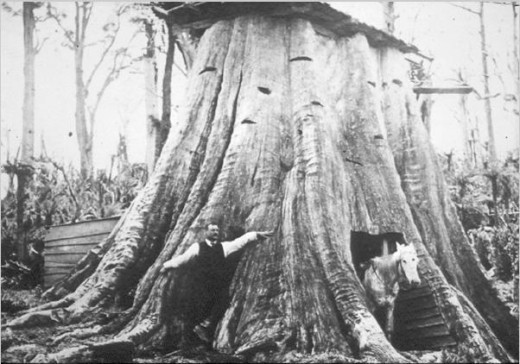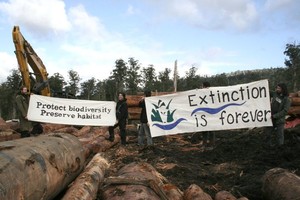They knew not what they did; lest we forget
Thursday, August 18th, 2011Gippsland Giants
by John Stephens
.
‘Do you know that possibly the biggest living thing in the world once lived in Gippsland and that its descendents still live here? No it’s not the blue whale, nor the giant kangaroo or the thylacine or even the black panther, it’s Eycalyptus regnans, the Victorian or Mountain Ash! These trees are the world’s tallest hardwoods and the tallest flowering plants.
The trees in the Tara Bulga Park are certainly imposing and of an impressive size, somewhere in the vicinity of sixty metres tall! You’ve seen Mountain Ash on drives or walks throughout the Strzelecki Ranges or the Baw Baw plateau. But I’m sorry to tell you, that you haven’t seen a real Mountain Ash and are most unlikely to ever see one. Of course I am talking about specimens that did exist before we “harvested” them. I don’t consider myself a “greenie” however I cannot be anything but amazed at the destructiveness of the human species.
During my “younger days” I spent many an enjoyable hour riding a motorcycle around the top end of Merriman and Traralgon Creeks. One of my greatest memories was seeing the stumps of some huge trees that had been logged, somewhere on the western side of the Merriman Creek headwaters, and imagining what they must have looked like in their original grandeur. I also came across the huge “historic” tree stumps at Mt Tassie and as many others have, I marvelled at their massive girth.
The Ada Tree near Powelltown, which is estimated to have existed for over three hundred years, is possibly the largest remaining specimen in Victoria. It has been preserved and is estimated to stand at about 76 metres, although it was significantly taller. The crown has been blown away either in a storm or struck by lightning, meaning the tree may have reached a height in the vicinity of 120 metres. Another giant, The Big Tree, in the Cumberland Tall Trees Reserve is 82 metres tall, but was 92 metres before a storm destroyed the top in 1959. What stuns me, is that if I imagine one of these trees to be the imposing Eucalyptus obliqua in the top corner of my block and it fell along the fence line, it would stretch the full 83 metres of the block!
 |
 |
I understand that to our pioneers the supply of forest, trees and timber seemed endless and they had a need to provide land for agriculture and development. However I do not understand their need to destroy everything that they saw as a challenge. Why did they have to destroy the Centennial Exhibition Tree that had stood in the Menzies Creek forest for hundreds of years until its demise in 1888? It was measured at over 122 metres after being felled and was reassembled for display at the exhibition in Melbourne. Surely it would have been better to take parties to visit the living tree in its natural surrounds and glory.
Part of an article written by Paul Edwards cleverly conveys what most of us feel about these giants – “When a tree gets old and tumbles, it becomes a noble thing — a fallen tree — but when it is cut down it turns into a log”. The best way to measure a tree is of course to do so when it has been cut down. This is essentially what happened to another giant at Thorpdale. It was felled in the1880s, measured by the surveyor G Cornthwaite, and found to have been 114.3 metres tall. I believe all that remains to signify the existence of this giant is a sign on the roadside indicating where it once stood, definitely far less impressive than the tree itself.
Some of these old trees must have been even more impressive. A 66 metre tall tree in Sassafras Gully in the Dandenongs and known as “The Baron” had a girth of 14.5 metres. The Bulga Stump, which was destroyed in the 1939 bushfires, famous for its huge girth of 34 metres! The Furmstons or Mueller Tree near Mt Monda was only 60 metres high when it fell in 1998 although it was estimated to be well over 100 metres when it was first discovered in the late nineteenth century. Another giant was a hollow stump in the Tarra Bulga area that had a roof and was used as a stable. The hollow Wonga Stump near Yarram was used as a church and a school until it was destroyed by fire in 1898.
The tallest known existing tree in the world is now a Californian Redwood (Sequoia semprivirens) found in the Humbolt Redwood State Park. It is 112.7 metres in height but is “small” compared to the tallest ever recorded, an American Douglas fir (Pseudotsuga menziesii) which was known to be 122 metres, equal to our Centennial Tree. However do these trees really compare to our own? A tree at Mt Baw Baw measured in 1889 by surveyor G W Robinson was reported to be 143 metres in height.
In 1872 the Victorian Government surveyor, William Ferguson, reported finding a fallen tree in the Healesville area that was 133 metres long. The top had been broken off in the fall and most of the crown burnt in a fire. Where it was broken the tree was approximately one metre in diameter and was estimated therefore to have been 152 metres tall!
Were there bigger specimens or are there still giants in the Gippsland forests? Maybe there was a tree of such dimensions that if in my imagination it fell the length of my block it would also complete the side boundary of the property behind mine.
[Source: ^http://home.vicnet.net.au/~apslvg/gippslandGiants.html]Title of this article is derived from two well known sayings:
- ‘Forgive them, for they know not what they do.’ Source: The Bible: ‘And Jesus said, “Father, forgive them, for they know not what they do.” And they cast lots to divide his garments.’
[© English Standard Version, Luke (23:34) 2001)]. These are supposedly Jesus’ words from the cross, asking forgiveness for those who put him to death. More widely, of course, the plea was for all humanity. [Rare historic photos of these magnificent trees are all that allow us to remember what once was. The saying is quite apt to old-growth trees, though I have removed the ‘Father, forgive them‘ clause.] - ‘Lest we forget‘ Source: Rudyard Kipling’s poem of 1897, ‘Recessional’, which he composed on the occasion of Queen Victoria’s Diamond Jubilee in 1897. The poem, on the one hand, expresses pride in the British Empire, but, on the other, expresses an underlying sadness that the Empire might go the way of all previous empires. [Again, quite apt to old-growth trees.]
.
‘God of our fathers, known of old—
Lord of our far-flung battle line—
Beneath whose awful hand we hold
Dominion over palm and pine—
Lord God of Hosts, be with us yet,
Lest we forget—lest we forget!
The tumult and the shouting dies—
The Captains and the Kings depart—
Still stands Thine ancient sacrifice,
An humble and a contrite heart.
Lord God of Hosts, be with us yet,
Lest we forget—lest we forget!
Far-called our navies melt away—
On dune and headland sinks the fire—
Lo, all our pomp of yesterday
Is one with Nineveh and Tyre!
Judge of the Nations, spare us yet,
Lest we forget—lest we forget!
If, drunk with sight of power, we loose
Wild tongues that have not Thee in awe—
Such boastings as the Gentiles use,
Or lesser breeds without the Law—
Lord God of Hosts, be with us yet,
Lest we forget—lest we forget!
For heathen heart that puts her trust
In reeking tube and iron shard—
All valiant dust that builds on dust,
And guarding calls not Thee to guard.
For frantic boast and foolish word,
Thy Mercy on Thy People, Lord!
Amen.
.
– end of article –









